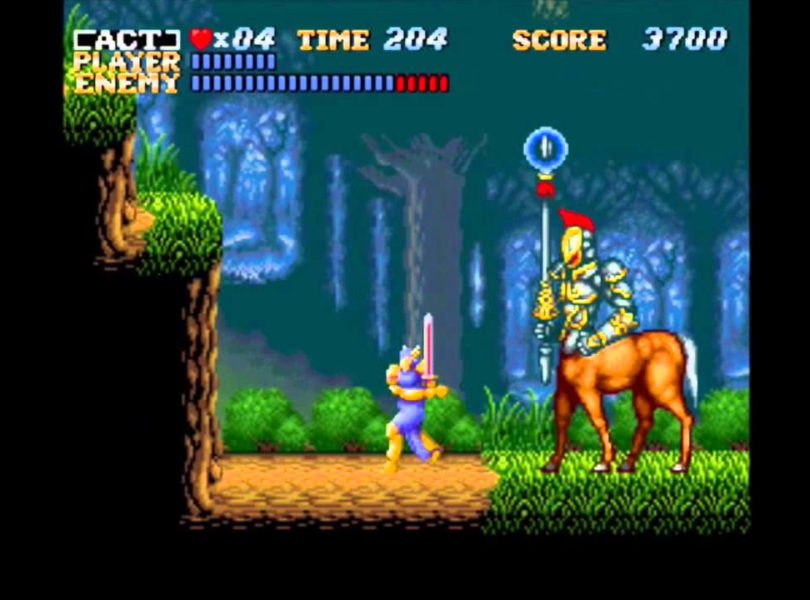Release Date: December 16, 1990
Developer: Quintet, Enix
Publisher: Enix
The debut of the Super Nintendo in the United States was not completely seamless. The Sega Genesis, the first true 16-bit console of the fourth generation, was already out and selling like hot cakes. Nintendo, for some reason, did not market their new 16-bit system too heavily. The system released in limited quantities on August 23, 1991; it wouldn’t see a full release nationwide until September 9, 1991. Worst of all, the SNES only had five games at launch. The Super Famicom, Japan’s version of the console, had released the year before and had a robust library of games. The fact Nintendo only had five titles for the launch of the Genesis’s primary competitor was disappointing.
Granted, the games that did launch were phenomenal: Super Mario World, F-Zero, Pilotwings, Graduis III, and SimCity. But there were a few other titles that were pegged as possible launch titles. ActRaiser, one of my all-time favorite SNES games, was one of them.
The game, developed by Quintet and published by Enix (this was before they bought SquareSoft), was a novel concept for its time. It is part-action platformer, part-city sim. The player assumes the role of “The Master”, a being who wakes after a very long sleep to discover that he has lost his powers. The reason for the lost powers is the lack of belief his people have in him. While he slept, the “Evil One” Tanzra has taken over the world, dividing the world up for his lieutenants and enslaving the people. As The Master, the player must drop from his sky palace and beat down Tanzra and his minions.
The platforming stages have the player wield a sword and take on Tanzra’s foot soldiers head-on. The goal here is straightforward: progress to the right, cleave any and all enemies, and then dispatch a boss character. The fighting and jumping are spot-on, and the boss battles are challenging enough.
In between platforming stages, you assume the role of the Master’s servant, a little cherub that fires arrows. The gameplay is now more sim-style. You move the servant around and build towns, clearing land to build housing and setting up crops for the villagers. In the process, you fight enemy monsters and help the villagers seal the portals where the monsters come from. The change in gameplay is welcome, though it may turn off some.
The action and sim phases play off each other. During the sim phase, the villagers will communicate with the Master through prayer. Occasionally, they will give offerings to the Master that teach him new magic spells he can then use when fighting in the action stages. The sim sections also progress the story and provide items that are used later in the game.
What made this game so awesome was the presentation. Graphically, this game was excellent. Everything was beautifully rendered, and the character sprites were very detailed. The bosses were imposing beasts, sometimes taking up the entire screen.
The real star of the game for me, however, is the musical score. Composer Yuzo Koshiro is practically a chiptune rock star, having penned the soundtracks for games like The Revenge of Shinobi and the Streets of Rage series on the Genesis. ActRaiser was his first major musical project, and he knocked it out of the park! This game’s score is considered by many to be one of the best ever in the 16-bit era. Just listen to the Fillmore Act I music, followed by the sim overworld music:
[arve url=”https://youtu.be/YLUlbnc11_w” autoplay=”no”]
The game was a great showcase of the SNES’s tricks. Every transition from the Master’s sky palace to ground level is shown in pure Mode 7 glory. The backgrounds showed off the SNES’s parallax scrolling abilities. This would have been a great launch title for the system.
So why wasn’t it a launch title? Part of the issue was Nintendo’s very strict policy against religious themes and symbols. In Japan, ActRaiser referred to The Master as God, and Tanzra was Satan. Several monster lairs also had Stars of David in them; these were changed to skulls. Another change that delayed it release was in difficulty. The US version of the game had its difficulty lowered in the platforming sections and heightened in the sim sections. Quintet also added a “Professional!” mode that unlocked after a first playthrough, ramped up difficulty, and removed the sim aspects of the game.
Does the game still hold up? Most definitely. The action in the platforming stages is still fun and precise, and I still enjoy the sim parts. This is one of my go-to games when I fire up my SNES, even if it’s just to hear the Fillmore Act I music!
Folks who want to play this gem are in luck. ActRaiser is available on the Virtual Console for the Wii and New 3DS. If you have never played this game before, I would suggest remedying that soon. The SNES was an absolute 16-bit powerhouse, and this game showed off many of the things that made the console awesome.
Good: Great gameplay; excellent graphics; unbelievably awesome music
Bad: Sim levels may not be everyone’s cup of tea
Final score: 9/10


